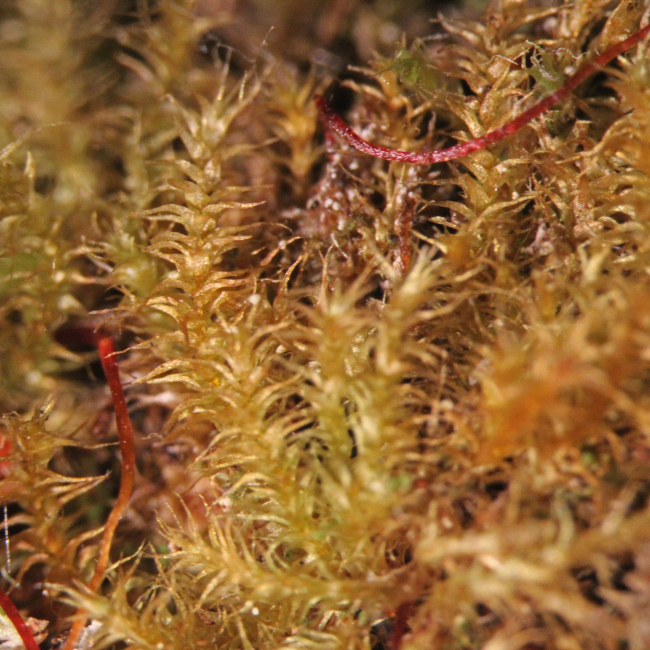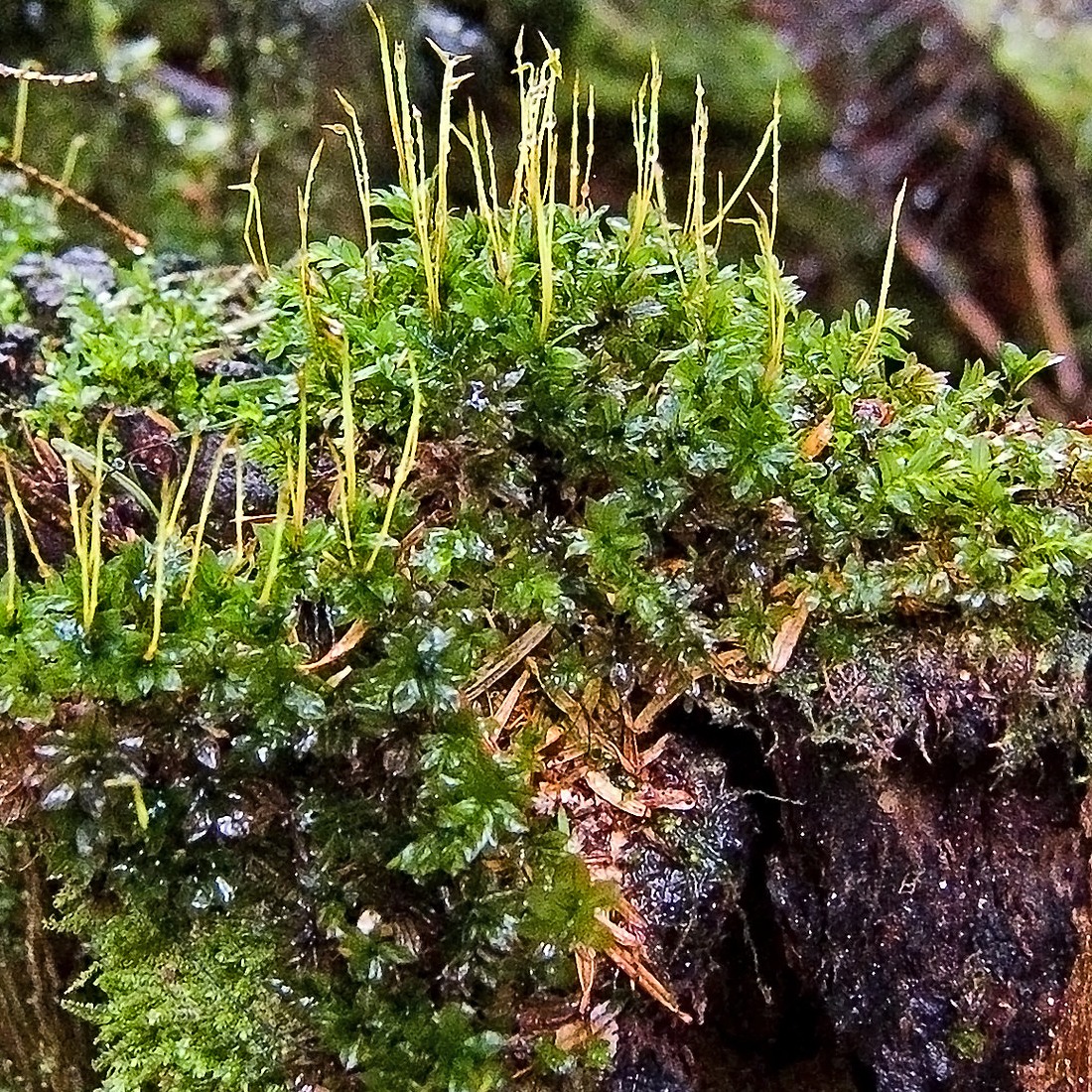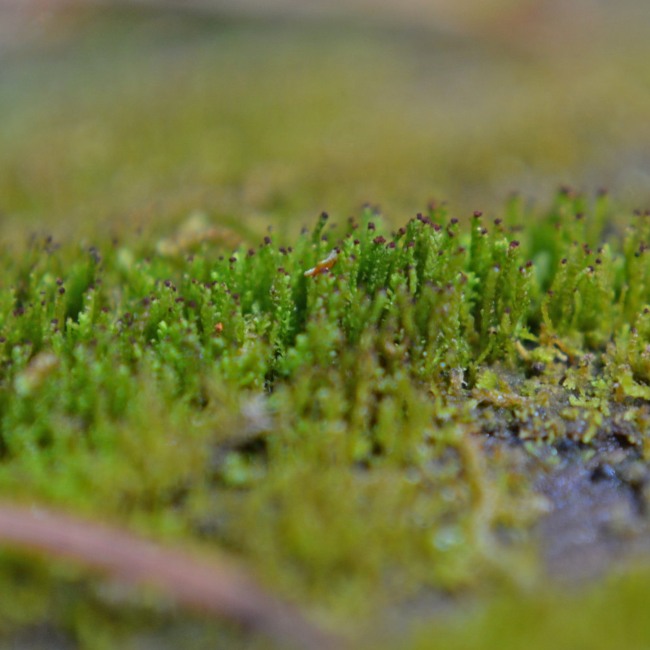Status of Mosses
In this section we explore how human disturbance effects mosses associated with old mixedwood and deciduous forests.
The overall intactness of old-forest moss species as measured by the Biodiversity Intactness Index was found to be, on average:
94.3%
Northern Operating Area
89.4%
Southern Operating Area
- This means most of the habitat for mosses is in good condition, but habitat suitability is lower in some areas due to human development activities.
- Habitat suitability is higher in the Northern Operating Area because there is less human footprint in this landbase compared to in the Southern Operating Area.
Introduction
Mosses provide several important functions in montane and boreal forest ecosystems[1]. For example, mosses:
- regulate soil moisture and temperature.
- intercept incoming nutrients, such as nitrogen, making these nutrients available to other plants.
- limit the establishment of understory plants as well as tree seedlings, thereby directly affecting the plant communities[2].
- are home to a diverse community of micro-organisms, such as fungi, bacteria, and mites that play critical roles in decomposing plant material and maintaining healthy soil[1, 3].
While mosses are common throughout the montane and boreal forest, many species have specialized habitat requirements[4], needing substrates such as the surfaces of decaying logs, or the rough, creviced bark of large old trees[5]. These requirements make many old-forest dependent moss species susceptible to disturbances like forest harvesting. A number of mosses and liverworts have been identified as indicators of closed-canopy forest health because these species decline in harvested sites.
Intactness and sector effects are summarized for moss species associated with old deciduous and mixedwood forests in Norbord’s operating areas. Details for calculating intactness and sector effects can be found in the Methods.
 Photo: Krista Williams
Photo: Krista Williams
Bristly Bentleaf Moss (Campylophyllum hispidulum)
Results
Biodiversity Intactness
The overall intactness of old-forest moss species as measured by the Biodiversity Intactness Index was found to be, on average:
Northern Operating Area
94.3%
22 species
Southern Operating Area
89.4%
23 species
Partner Operating Area
92.5%
23 species
2018 Highlights
- Habitat suitability for moss species associated with old deciduous and mixedwood forests, as indicated by intactness, is higher in the Northern Operating Area compared to in the Southern Operating Area; this can be attributed to the lower amount of human footprint in the north.
- In the Northern Operating Area, 21 species were within 10% of intact reference conditions, with only two species—Red-mouthed Leafy Moss and Heller’s Notchwort—experiencing intactness deviations larger than 10% from intact reference conditions.
- In the Southern Operating Area, 14 species were within 10% of intact reference conditions, with intactness effects ranging from 73.7% to 88.3% for the remaining 9 species.
- The species that consistently showed the largest deviations from intact reference conditions in both operating areas are most abundant in old forests, particularly mixedwood stands. These species increase in abundance with stand age.

Red-mouthed Leafy Moss (Mnium spinulosum)

Heller's Notchwort
(Anastrophyllum hellerianum)
Results
Sector Effects
Local Scale Sector Effects
Local scale sector effects are used to understand what industrial sectors are most affecting the abundance of moss species associated with old deciduous/mixedwood forests in Norbord’s operating areas. Changes in species' relative abundance are predicted within each sector’s footprint compared to the reference conditions with no human footprint.
- All types of human disturbances greatly decrease habitat suitability for almost all moss species associated with old deciduous and mixedwood forests in the operating areas because these activities impact their preferred habitat.
- Within forestry footprint, the abundance of most old-forest moss species is predicted to be less abundant than expected compared to in the habitat it replaces, with 75% and 87% of species predicted to be less abundant in the Southern and Northern Operating Areas, respectively.
- A few species, such as Tinyleaf Small Plume Moss and Bristly Bentleaf Moss, while associated with old-forest habitat, also respond positively to harvest areas and are therefore more abundant than expected in forestry footprint.
Regional Population Effects
Regional population effects reflect the total expected change for the population of each old- forest moss species across Norbord’s operating areas due to each sector’s footprint. This incorporates the area of the footprint, the native habitats in the region where the footprint occurs, and the species response to a particular footprint. The calculation also incorporates the entire landbase of each operating area, large tracts of which have no human footprint.
- Regional effects are much less than local scale footprint effects because a great deal of old-forest moss habitat has not been disturbed by human footprint in Norbord’s operating areas; more area has been disturbed in the Southern Operating Area resulting in larger predicted changes.
- Regional population effects of agriculture, transportation, energy, and urban/industrial footprint, on old-forest mosses were small—ranging from -2.9% to +1.6% in all three operating areas.
- Forestry footprint resulted in the largest predicted changes to suitable habitat for most old-forest mosses—as much as -17.4%, -21.6%, and -15.1% in the Northern, Southern, and Partner Operating Areas, respectively—because harvesting is the largest footprint type in all three operating areas and disturbs the most native vegetation.
- There are predicted to be small increases in the regional population of three moss species due to forestry footprint: Tinyleaf Small Plume Moss, Bristly Bentleaf Moss, and Golden Feather-moss.
To view species-specific sector effects, use the drop-down menu to select a species of interest.
Northern Operating Area - Local Scale Sector Effects
Figure: Local Scale Sector Effects. Predicted per cent change in species' relative abundance inside areas that have been disturbed by each sector (human footprint type) compared to reference conditions with no human footprint. Local scale sector effects values less than 0% indicate fewer mosses in that type of footprint than in the reference habitat; values greater than 0% indicate more mosses.
Northern Operating Area - Regional Scale Sector Effects
Figure: Regional Sector Effects. Predicted per cent change in the total regional population of mosses, by species, due to the footprints of each industrial sector. Regional sector effect values less than 0% indicate a predicted decrease in the regional population due to a sector's footprint and values greater than 0% indicate a predicted increase. Note that sector effects consider only the direct impact of disturbed areas and do not consider edge effects or other non-footprint effects (e.g., noise, pollution).
Southern Operating Area - Local Scale Sector Effects
Figure: Local Scale Sector Effects. Predicted per cent change in species' relative abundance inside areas that have been disturbed by each sector (human footprint type) compared to reference conditions with no human footprint. Local scale sector effects values less than 0% indicate fewer mosses in that type of footprint than in the reference habitat; values greater than 0% indicate more mosses.
Southern Operating Area - Regional Scale Sector Effects
Figure: Regional Sector Effects. Predicted per cent change in the total regional population of mosses, by species, due to the footprints of each industrial sector. Regional sector effect values less than 0% indicate a predicted decrease in the regional population due to a sector's footprint and values greater than 0% indicate a predicted increase. Note that sector effects consider only the direct impact of disturbed areas and do not consider edge effects or other non-footprint effects (e.g., noise, pollution).
References
Turestsky, M.R., B. Bond-Lamtery, E. Euskirchen, J. Talbot, S. Frolking, A.D. McGuire, and E-S. Tuittila. 2012. The resilience and functional role of moss in boreal and arctic ecosystems. New Phytologist 196:49-67.
Sanderson, L.A., J.A. McLaughlin, and P.M. Antunes. 2012. The last great forest: a review of the status of invasive species in the North American boreal forest. Forestry 85(3):329-339.
Lindo, Z., and A. Gonzalez. 2010. The bryosphere: an integral and influential component of the Earth's biosphere. Ecosystems 13:612-627.
Hazell, P., O. Kellner, H. Rydin, and L. Gustafsson. 1998. Presence and abundance of four epiphytic bryophytes in relation to density of aspen (Populus tremula) and other stand characteristics. Forest Ecology and Management 107(1-3):147-158.
Crites, S. and M.R.T. Dale. 1998. Diversity and abundance of bryophytes, lichens and fungi in relation to woody substrate and successional stage in aspen mixedwood boreal forests. Canadian Journal of Botany 76:641-651.




